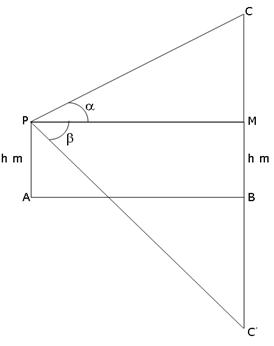Can someone help me solve this question which is from the chapter Some Applications of Trigonometry.

Dear Student
Let be the surface of the lake and be the point vertically above such that m.
Let be the position of the cloud and be its reflection on the lake.
Let the height of the cloud be metres. Thus, we have:
m
Draw ⊥.
Thus, we have:
∠ and ∠
m
m and m

From the right ∆, we have:
⇒
⇒ ...(i)
From the right ∆, we have:
⇒
⇒ ...(ii)
From (i) and (ii), we get:
⇒
⇒
⇒ ...(iii)
Using the value of in (i), we get:
...(iv)
Now, to find , we have:
⇒
Putting the value of from (iv), we get:
The distance of the cloud =
Hence proved
Regards
Let be the surface of the lake and be the point vertically above such that m.
Let be the position of the cloud and be its reflection on the lake.
Let the height of the cloud be metres. Thus, we have:
m
Draw ⊥.
Thus, we have:
∠ and ∠
m
m and m

From the right ∆, we have:
⇒
⇒ ...(i)
From the right ∆, we have:
⇒
⇒ ...(ii)
From (i) and (ii), we get:
⇒
⇒
⇒ ...(iii)
Using the value of in (i), we get:
...(iv)
Now, to find , we have:
⇒
Putting the value of from (iv), we get:
The distance of the cloud =
Hence proved
Regards



 CPM,
CPM,